Behind the scenes at Kingston Technology
October 21, 2009 | 09:34

Performance Memory
Kingston's HyperX T1 products have had respectfully little exposure among enthusiasts, and Kingston itself admits its products are a gesture to the performance community. Rightly or wrongly, it came across as not much more than a lukewarm marketing exercise rather than a serious endeavor. Despite claiming goals such as being the first to launch and ship real 2,133MHz DDR3 Lynnfield kits, we would challenge anyone reading this to admit to knowing that already.After an admittedly stimulating few days talking to some extremely insightful people about the future of memory technology, it quite literally has us smacking our hands against our foreheads at the overwhelmingly careful corporatism. Instead of perusing the interesting end of the industry (as interesting as memory can be), which full of extremely passionate people like yourselves reading, Kingston negates all the potential HyperX could be.
With Kingston’s buying power, expertise and investment in compatibility, it has the clear potential to own the high performance market. Perhaps companies such as Corsair and OCZ should be thankful it doesn’t care, only concentrating on that ever important dollar per employee factor, rather than pursuing investment on brand name with people (you) that buy memory upgrades the most often and educate others.
We have to admit though that we do see the point made that if it can attract one IT manager, that’s a lifetime of thousands of upgrades for corporate notebooks, servers and SSDs. The other benefit to us is that we get fantastic consumer choice (well, the Americans get way more from Newegg).
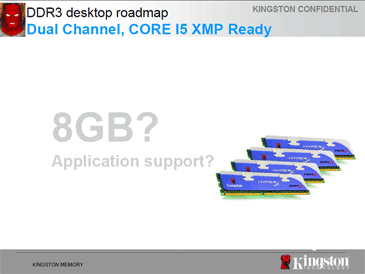
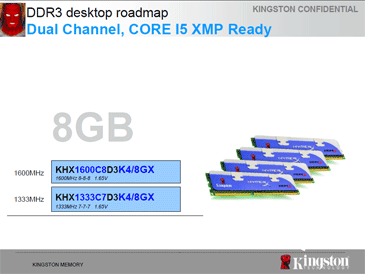
Kingston claims there is "no demand" for 8GB kits as there's no application support to use that much. We disagree: High performance users that heavily multi-task have been making use of 8GB systems since DDR2 became affordable.
Kingston claims it’s not fair to produce a product no one or very few can buy and 20 or 30 kits isn’t “a product” (when it typically sells “100s of 2,133MHz kits”), but at the same time when did we ever care about what second place had to offer? To quote Kingston directly, “HyperX is in the market to meet customer demands not to generate buzz”. Surely for a market that lives off the next new product excitement, the two are inherently linked? We feel the answer is a corporate cop-out, simply because Kingston is not willing to invest resources, risking its pinnacle dollar-per-employee factor, in our respectively smaller market.
Not only is it speed, but capacity too: we know a fair few invested in 8GB of DDR2 because the price was so cheap, or that having lived with 4GB of DDR2, "upgrading" to 4GB of DDR3 doesn’t feel like the next step to many. The attitude of “what programs use more than 4GB” and “we don’t see a demand now”, to me, clearly shows Kingston doesn’t know its workstation and high performance user. bit-tech and Custom PC consider the absolute minimum is 4GB these days for multi-taskers, because why else would you buy a quad core processor?
We had no idea DDR3 DIMMs could have a temperature sensor, and really, why not? Knowing the ins-and-outs of any system is the metaphorical crack to an enthusiast; we need it. So given Kingston's technical expertise and considering we know it's engineering PCBs and server hardware on site, how hard is it to apply the same technology to its HyperX T1s to create a market niche?
Server Memory
Finally, talking about servers: if you thought we'd got rid of FB-DIMMs then think again. Although Intel has renounced plans for future use of FB-DIMM technology, the new "LR-DIMM" is on the horizon for the first half of next year. Yes, those latency heavy memory products are back, although this time there are benefits (and they shouldn't run so hot either!);You may already know that triple-channel Core i7 900 CPUs have a hard time scaling the memory bus in comparison the dual channel Core i5 700 and i7 800 CPUs. The more DIMMs that are added, the harder it is to compensate for factors like crosstalk on PCB and the clock drive from the memory controller, all while increasing frequency. "Load Reduction" DIMMs take off the stress off the memory bus by incorporating a full-buffer-esq AMB chip that, well, buffers all the requests and data signals between the memory controller and memory chips on the DIMM, significantly simplifying the tracing on the motherboard.
It is still a latency intensive operation, but the advantage is that LR-DIMMs can scale the frequency of server memory much, much better allowing for a much larger bandwidth. What's more, the AMB chip works in sync with the frequency of the whole memory bus, so it's not quite so bad.
Micron, who released engineering samples for its first generation LR-DIMMs earlier this year, claimed a potential of tripling the memory capacity per DIMM, all while increasing performance by 57 per cent and reducing memory bus load by 50 to 75 per cent, depending on the amount of ICs used per module. Win, win, win, by the sounds of it. Micron already has 8GB DIMMs running right now, but claims by the time server boards arrive to use it next year, 16GB DIMMs will be available.
If you're still reading, then you might want to click here to learn more.

MSI MPG Velox 100R Chassis Review
October 14 2021 | 15:04

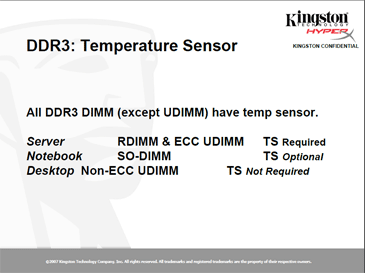
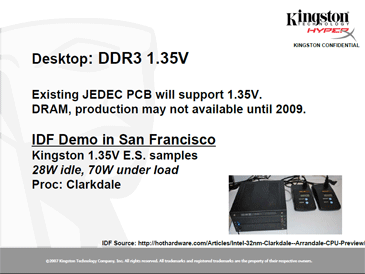
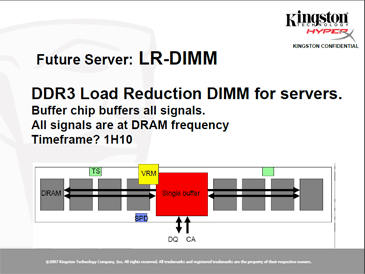
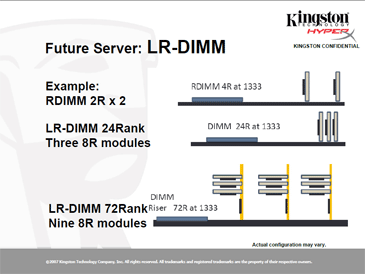







Want to comment? Please log in.